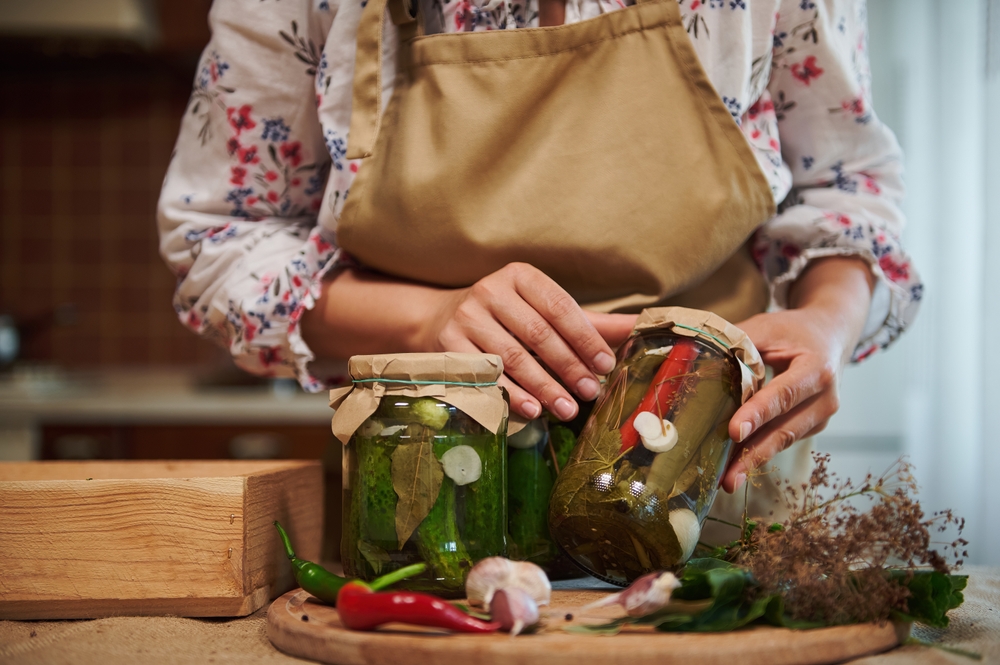That pile of fresh herbs sitting in your garden or kitchen might look potent, but they’re actually keeping most of their therapeutic compounds locked away in cellular structures that your body can’t easily access. Fermentation is nature’s way of breaking down these barriers and transforming plant materials into concentrated, bioavailable forms that can deliver dramatically more powerful health benefits than their fresh counterparts.
The process of controlled fermentation doesn’t just preserve herbs, it fundamentally changes their chemical composition in ways that often make them more therapeutically active than they ever were in their original state. What starts as a simple leaf can become a complex mixture of beneficial compounds that never existed in the original plant.
Traditional cultures around the world discovered this fermentation secret thousands of years ago, creating herbal preparations that were far more potent and effective than anything we typically see in modern herbal medicine. The knowledge of how to properly ferment herbs for maximum potency was often closely guarded and passed down through generations of healers who understood its transformative power.
Why fresh herbs are actually nutritional prisons
Plant cells are surrounded by tough cellulose walls that act like microscopic safes, protecting valuable compounds from being easily extracted or absorbed. When you consume fresh herbs, your digestive system can only access a fraction of their beneficial compounds because these cellular barriers remain largely intact.
The active compounds in fresh herbs are often bound to other molecules or stored in forms that aren’t readily bioavailable to human physiology. Your body has to work hard to break down these plant structures and extract usable compounds, often with limited success.
Many of the most powerful therapeutic compounds in plants are actually produced as secondary metabolites during stress responses or enzymatic processes that don’t occur until the plant material is damaged or begins to break down. Fresh, intact herbs haven’t gone through these beneficial chemical transformations.
The water content in fresh herbs can actually dilute the concentration of active compounds while also providing an environment where beneficial enzymatic processes can’t occur optimally. Controlled fermentation removes excess water while concentrating beneficial compounds.
How fermentation unlocks hidden therapeutic compounds
During fermentation, beneficial microorganisms produce enzymes that break down the tough cellulose walls of plant cells, releasing therapeutic compounds that were previously inaccessible. These same microorganisms also create new beneficial compounds through their metabolic processes that weren’t present in the original plant material.
The controlled breakdown of plant proteins during fermentation creates bioactive peptides and amino acids that can have therapeutic effects beyond what the original plant provided. These fermentation-derived compounds often have enhanced bioavailability and more targeted therapeutic actions.
Fermentation also converts many plant compounds into more active forms through processes like glycoside hydrolysis, where complex sugar-bound molecules are broken down into simpler, more readily absorbed forms. This transformation can increase the therapeutic potency of herbs by several times their original strength.
The acidic environment created during proper fermentation can also enhance the stability and bioavailability of certain therapeutic compounds while creating conditions that promote the formation of new beneficial molecules through chemical reactions that don’t occur in fresh plants.
The microbial magic that transforms ordinary leaves
Beneficial bacteria and yeasts involved in herbal fermentation don’t just break down plant material, they actively synthesize new therapeutic compounds through their metabolic processes. These microorganisms can create vitamins, enzymes, and other bioactive molecules that enhance the therapeutic potential of the original herbs.
Different types of fermentation microorganisms produce different therapeutic effects, which is why traditional fermentation methods often used specific environmental conditions to encourage particular types of beneficial microbes. The selection and cultivation of these microorganisms was a sophisticated art that determined the final potency of fermented herbs.
The symbiotic relationship between fermentation microorganisms and plant compounds can create synergistic effects where the combination becomes more therapeutically active than either the herbs or the microorganisms would be alone. This biological collaboration produces compounds that couldn’t be created through any other process.
Some fermentation microorganisms can actually detoxify harmful compounds that might be present in certain herbs, making them safer for consumption while simultaneously enhancing their beneficial properties. This dual action of detoxification and potentiation makes fermented herbs often superior to their fresh counterparts.
Why fermentation timing determines therapeutic power
The duration of fermentation dramatically affects the types and concentrations of therapeutic compounds produced. Short fermentation periods might focus on breaking down cellular barriers and improving bioavailability, while longer fermentation can create entirely new therapeutic compounds through more complex biochemical processes.
Different therapeutic compounds are optimized at different stages of the fermentation process, which is why traditional fermentation methods often involved specific timing protocols to maximize desired effects. Understanding these timing relationships was crucial knowledge that separated master herbalists from casual practitioners.
Environmental factors like temperature, humidity, and oxygen levels during fermentation can influence which therapeutic pathways are activated and which compounds are produced. Traditional fermentation methods often involved careful control of these conditions to optimize therapeutic outcomes.
The pH changes that occur throughout fermentation create different chemical environments that favor the formation of different therapeutic compounds. Skilled practitioners learned to monitor and control these pH changes to guide fermentation toward producing specific desired therapeutic effects.
The temperature secrets that make or break fermentation
Most therapeutic fermentation occurs at relatively low temperatures that preserve delicate compounds while allowing beneficial enzymatic processes to proceed slowly and completely. High temperatures can destroy many therapeutic compounds while promoting the wrong types of microbial activity.
Cold fermentation methods, often used in traditional medicine systems, can take weeks or months but produce exceptionally potent and stable therapeutic compounds. These slow, controlled processes allow for complex biochemical transformations that can’t occur under faster, warmer conditions.
Temperature fluctuations during fermentation can actually enhance therapeutic potency by creating stress conditions that promote the production of beneficial secondary metabolites. Some traditional methods deliberately used controlled temperature changes to maximize therapeutic compound formation.
The optimal temperature for fermentation varies significantly between different herbs and desired therapeutic outcomes, which is why traditional fermentation knowledge was often plant-specific and required deep understanding of individual herbs’ biochemical properties.
How different fermentation methods create different healing properties
Lactic acid fermentation, which creates an acidic environment, is particularly effective for herbs where the therapeutic compounds are enhanced by acidic conditions or where harmful microorganisms need to be suppressed. This type of fermentation often produces herbs with enhanced digestive and antimicrobial properties.
Alcoholic fermentation can extract and concentrate different types of therapeutic compounds, particularly those that are alcohol-soluble, while also creating new therapeutic alcohols and esters through the fermentation process. These alcohol-fermented herbs often have enhanced absorption and different therapeutic profiles.
Wild fermentation, which relies on naturally occurring microorganisms, can produce more complex therapeutic profiles than controlled fermentation because multiple types of beneficial microorganisms work together to create diverse therapeutic compounds. However, this method requires more skill to control properly.
Anaerobic fermentation, which occurs without oxygen, promotes different biochemical pathways and can create therapeutic compounds that don’t form under aerobic conditions. Many traditional fermentation methods deliberately created anaerobic conditions to optimize specific therapeutic outcomes.
The pH transformation that supercharges bioavailability
The pH changes that occur during fermentation can dramatically improve the bioavailability of therapeutic compounds by converting them into forms that are more easily absorbed by human digestive systems. Many plant compounds that are poorly absorbed at neutral pH become highly bioavailable under the acidic or alkaline conditions created during fermentation.
Fermentation-induced pH changes can also enhance the stability of therapeutic compounds, preventing their degradation during storage and improving their therapeutic shelf life. This stabilization effect is one reason why traditionally fermented herbs often retained their potency for years.
The buffering effects created by fermentation can help therapeutic compounds survive the harsh acidic environment of the stomach, allowing them to reach the intestines where they can be properly absorbed. This protective effect significantly enhances the therapeutic effectiveness of fermented herbs.
pH optimization during fermentation can also promote the formation of therapeutic complexes between different plant compounds, creating synergistic effects that enhance overall therapeutic potency beyond what individual compounds could achieve alone.
Why fermented herbs often work when fresh ones fail
The enhanced bioavailability of fermented herbs means they can produce therapeutic effects at much lower doses than fresh herbs, making them more practical and cost-effective for therapeutic use. This concentration effect also reduces the bulk of plant material needed to achieve therapeutic outcomes.
Fermentation can eliminate or reduce compounds that might interfere with therapeutic absorption or cause digestive upset, making fermented herbs more tolerable and effective for sensitive individuals. This purification effect makes fermented herbs suitable for people who can’t tolerate fresh herbs.
The slow-release characteristics of many fermented herbs provide sustained therapeutic effects rather than the quick peaks and drops that can occur with fresh herbs. This sustained action often produces better therapeutic outcomes with less frequent dosing.
Fermented herbs often have improved shelf stability compared to fresh herbs, maintaining their therapeutic potency for extended periods without refrigeration or special storage conditions. This stability makes them more practical for regular therapeutic use.
The traditional fermentation wisdom that modern herbalism forgot
Many traditional medicine systems included sophisticated fermentation techniques that dramatically enhanced herbal potency, but much of this knowledge was lost during the modernization of herbal medicine. Contemporary herbalism often focuses on fresh or simply dried herbs, missing the potency enhancements that fermentation provides.
Traditional fermentation methods were often location-specific, taking advantage of local environmental conditions and native microorganisms to create unique therapeutic preparations that couldn’t be replicated elsewhere. This geographical specificity meant that different regions developed different fermentation specialties.
The integration of fermentation with other traditional preparation methods, such as specific harvesting times, pre-fermentation treatments, and post-fermentation processing, created comprehensive systems for maximizing herbal potency that modern practitioners are only beginning to understand.
Traditional practitioners often spent years learning the subtle signs and techniques needed to properly ferment herbs for maximum therapeutic benefit. This specialized knowledge was considered as valuable as knowledge about the herbs themselves.
Simple fermentation techniques for maximum herbal potency
Basic wild fermentation can be started with just herbs, water, and time, allowing naturally occurring beneficial microorganisms to begin the transformation process. This simple approach can significantly enhance herbal potency even without sophisticated equipment or techniques.
Salt-brine fermentation creates an environment that favors beneficial lactic acid bacteria while suppressing harmful microorganisms. This method is particularly effective for leafy herbs and creates therapeutically enhanced preparations with excellent shelf stability.
Honey fermentation combines the therapeutic properties of raw honey with herbs, creating preparations that are both more potent and more palatable than other fermentation methods. The natural antimicrobial properties of honey help control the fermentation process while adding additional therapeutic compounds.
Controlled temperature fermentation using simple equipment like heating mats or fermentation chambers allows for more precise control over the fermentation process, enabling optimization for specific therapeutic outcomes or herb types.
Your fermentation laboratory for therapeutic herbs
Starting with simple, safe fermentation methods allows you to experience the potency enhancement that fermentation provides while developing the skills and knowledge needed for more advanced techniques. Begin with hardy herbs and basic methods before progressing to more delicate plants or complex fermentation processes.
Understanding the signs of successful fermentation versus spoilage is crucial for safely producing therapeutically enhanced herbs. Learning to recognize proper fermentation colors, smells, and textures ensures both safety and therapeutic effectiveness.
Keeping detailed records of fermentation conditions, timing, and outcomes helps you develop the knowledge needed to consistently produce therapeutically enhanced herbs. Traditional practitioners often maintained detailed fermentation records that guided their practice for decades.
The transformation of ordinary herbs into therapeutically supercharged preparations through fermentation represents one of the most powerful and underutilized techniques in natural healing. Your herbs are waiting to reveal their hidden therapeutic potential through the ancient art of controlled fermentation.


















